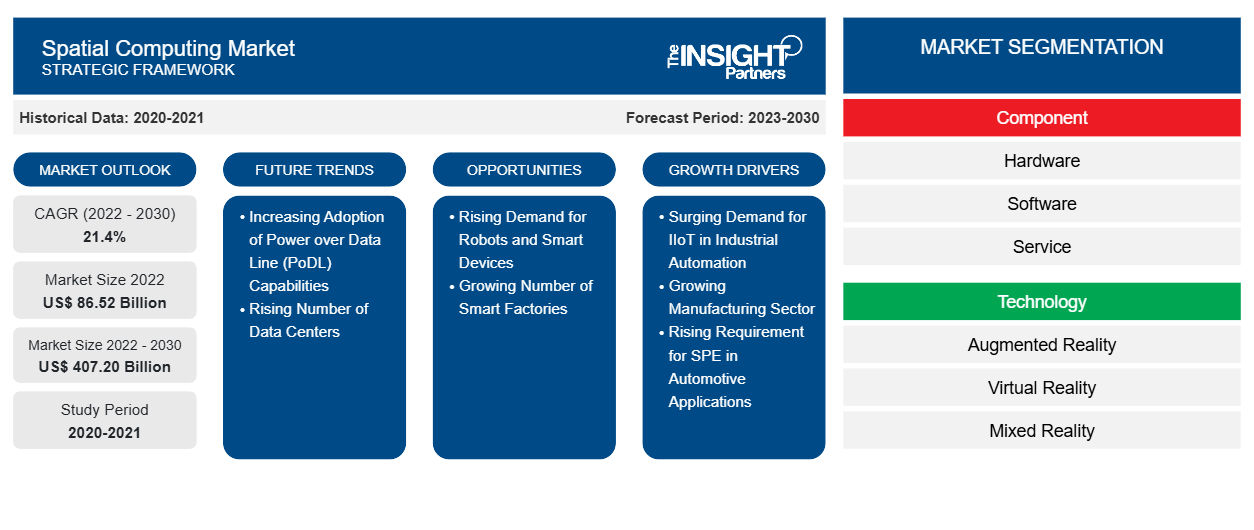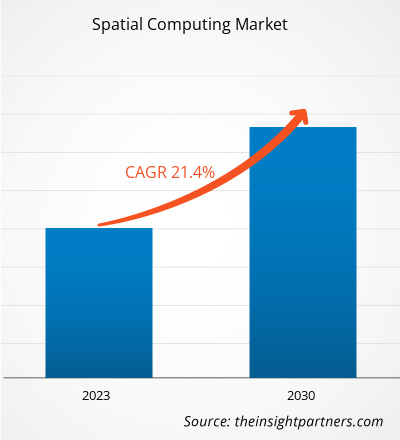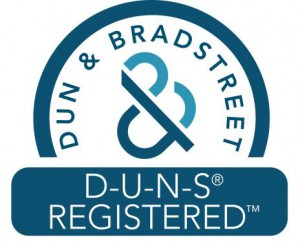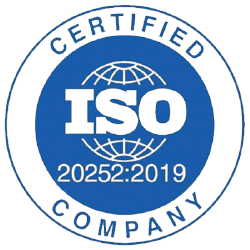The spatial computing market size was valued at US$ 86.52 billion in 2022 and is expected to reach US$ 407.20 billion by 2030; it is estimated to record a CAGR of 21.4% from 2022 to 2030. Technological advancement and penetration of mixed reality is likely to remain key spatial computing market trends.
Spatial Computing Market Analysis
Modern Internet, also termed Web 3.0, utilizes a suite of advanced technologies that render computers increasingly invisible. It is done by integrating the user interface (UI) into the physical environment. Spatial computing technology seamlessly integrates computers into the environment by utilizing human’s natural spatial capabilities to increase productivity.
Spatial computing is anticipated to dramatically change daily activities and has already had a huge influence on how people live. A simple example of the spatial computing revolution is social media location tagging. While it may be considered as a basic component of any social media post, it presents a robust context to users through location-specific information and generates insights about target audiences. Using a vehicle or phone’s Global Positioning System (GPS) system is another example of the technology revolution.
In many cases, the power that these technologies can offer increases when they operate in synergy with one another rather than in isolation. To address this, Institute of Electrical and Electronics Engineers (IEEE) protocol for Web 3.0, aka the Spatial Web/metaverse, was released. It offers technical standards for these technologies to communicate with each other in an organized and harmonious way.
Spatial Computing Market Overview
The report includes growth prospects in light of current spatial computing market trends and driving factors influencing the market growth. The global market is experiencing extensive growth and is estimated to continue expanding in the coming years. Spatial computing can be termed as the digitization of actions involving machines, objects, people, and the environments in which they occur, for enabling and optimizing actions and interactions. The technology contains the potential to digitally transform how industrial enterprises optimize operations for frontline workers in factories, worksites, and warehouses and to enable digitally augmented dimensional context for enterprise actions and interactions. Over the past few years, there have been advancements in the technologies, such as artificial intelligence (AI), machine learning (ML), natural language processing (NLP), camera sensors, computer vision, Internet of Things (IoT), virtual reality (VR), augmented reality (AR), mixed reality (MR), and extended reality (XR), that are making spatial computing possible. The spatial computing market forecast is estimated by considering all such trends, along with various secondary and primary research findings.
Customize This Report To Suit Your Requirement
You will get customization on any report - free of charge - including parts of this report, or country-level analysis, Excel Data pack, as well as avail great offers and discounts for start-ups & universities
Spatial Computing Market: Strategic Insights

- Get Top Key Market Trends of this report.This FREE sample will include data analysis, ranging from market trends to estimates and forecasts.
You will get customization on any report - free of charge - including parts of this report, or country-level analysis, Excel Data pack, as well as avail great offers and discounts for start-ups & universities
Spatial Computing Market: Strategic Insights

- Get Top Key Market Trends of this report.This FREE sample will include data analysis, ranging from market trends to estimates and forecasts.
Spatial Computing Market Drivers and Opportunities
Advancements in Real-Time Rendering Engine Fuels Spatial Computing Market Growth
Current software and available technology have lifted rendering from being limited to computer enthusiasts to a rapidly expanding field that includes architects, artists, developers, engineers, and others. Despite certain limits to the technology, professionals constantly perform research on integrations of various multivariate technologies to ensure mainstream rendering and visualization. The applications of AI to aid in the rendering process are gaining ground in the field of architectural visualization. Without the need for manual optimization, users can utilize ML algorithms and deep neural networks (DNN) to generate more lifelike and nuanced visualizations. With the help of AI, the rendering process can be further fine-tuned to improve speed and efficiency. Such advancements contribute to the growing spatial computing market size.
Spatial Computing Market Report Segmentation Analysis
Key segments that contributed to the derivation of the spatial computing market analysis are component, technology, and end user.
- Based on component, the market is segmented into hardware, software, and service. The market for the hardware segment is further bifurcated into headsets and others. In 2022, the hardware segment held a larger share of the market.
- Based on technology, the market is segmented into augmented reality (AR), virtual reality (VR), and mixed reality (MR). The large enterprises segment dominated the market in 2023 owing to the growing investments by large enterprises in meeting management software.
- In terms of end user, the market is segmented into architecture, engineering, & Construction (AEC); consumer; education; healthcare; retail; and others. Meeting management software is widely used in corporate settings. Also, government, education, and other end users are adopting the meeting management software significantly.
Spatial Computing Market Share Analysis by Geography
- In terms of revenue, North America dominated the spatial computing market share in 2022. APAC is expected to grow at the fastest pace during the forecast period. The market in APAC is segmented into Australia, China, India, Japan, South Korea, and the Rest of APAC. The region is diverse in terms of demographics. It is one of the largest technology research hubs, and the majority of the world’s semiconductors are manufactured in the region.
- With the growing requirement for advanced manufacturing technologies, manufacturers in the region adopt AR and VR technologies at a fast pace. Since nations such as the US, Germany, and the UK are increasing their stringency on imported products, suppliers from APAC are significantly opting for spatial computing technologies as a means to better adhere to such regulations and requirements.
- Precision medicine is gaining prominence with the growing trend of specialized and personalized patient care in APAC. Rising prevalence of lifestyle diseases and increasing awareness of such diseases are certain factors promoting precision and personalized medicines. To provide more effective care, the individual needs of a patient are combined with spatial computing for designing such medicines. Spatial computing is also being utilized from drug molecule screening to medical device production. All these factors fuel the spatial computing market growth in APAC.
Spatial Computing Market News and Recent Developments
The spatial computing market is evaluated by gathering qualitative and quantitative data post primary and secondary research, which includes important corporate publications, association data, and databases. The following is a list of developments in the spatial computing market:
- In March 2024, Cromwell Hospital in London, owned by Bupa, disclosed that their surgical team utilized MR headset for two microsurgical spine procedures. The surgeons employed Apple's Vision Pro headset to facilitate medical procedures, marking a notable advancement in healthcare technology. Following its release in the US, Apple's Vision Pro has seen a surge in healthcare applications compatible with the device, as highlighted in an Apple press release. Notable among these is Stryker's Mako SmartRobotics app, tailored for surgeons performing hip and knee replacements.
(Source: Cromwell Hospital, Press Release)
- In September 2023, pre-orders for Meta Quest 3 were initiated. The world’s first mass-market MR headset’s price was announced, which started from US$ 499.99 for the 128GB version and US$ 649.99 for the 512GB variant. Meta Quest 3 features breakthrough MR that enables a spectrum of experiences and was the world’s first device to feature the new Snapdragon XR2 Gen 2 platform.
(Source: Meta, Press Release)
Spatial Computing Market Regional Insights
The regional trends and factors influencing the Spatial Computing Market throughout the forecast period have been thoroughly explained by the analysts at The Insight Partners. This section also discusses Spatial Computing Market segments and geography across North America, Europe, Asia Pacific, Middle East and Africa, and South and Central America.
Spatial Computing Market Report Scope
| Report Attribute | Details |
|---|---|
| Market size in 2022 | US$ 86.52 Billion |
| Market Size by 2030 | US$ 407.20 Billion |
| Global CAGR (2022 - 2030) | 21.4% |
| Historical Data | 2020-2021 |
| Forecast period | 2023-2030 |
| Segments Covered |
By Component
|
| Regions and Countries Covered | North America
|
| Market leaders and key company profiles |
|
Spatial Computing Market Players Density: Understanding Its Impact on Business Dynamics
The Spatial Computing Market is growing rapidly, driven by increasing end-user demand due to factors such as evolving consumer preferences, technological advancements, and greater awareness of the product's benefits. As demand rises, businesses are expanding their offerings, innovating to meet consumer needs, and capitalizing on emerging trends, which further fuels market growth.

- Get the Spatial Computing Market top key players overview
Spatial Computing Market Report Coverage and Deliverables
The "Spatial Computing Market Size and Forecast (2022–2030)" provides a detailed analysis of the market covering the areas mentioned below:
- Market size and forecast at global, regional, and country levels for all the key market segments covered under the scope
- Market dynamics such as drivers, restraints, and key opportunities
- Key future trends
- Detailed PEST/Porter's Five Forces and SWOT analysis
- Global and regional market analysis covering key market trends, major players, regulations, and recent market developments
- Industry landscape and competition analysis covering market concentration, heat map analysis, prominent players, and recent developments
- Detailed company profiles
Frequently Asked Questions
Which is the fastest growing regional market?
Which region is holding the major market share of global spatial computing market?
Which is the leading component segment in the spatial computing market?
Which are the key players holding the major market share of spatial computing market?
What is the estimated global market size for the spatial computing market in 2022?
What are the future trends of the spatial computing market?
What are the driving factors impacting the spatial computing market?
- Historical Analysis (2 Years), Base Year, Forecast (7 Years) with CAGR
- PEST and SWOT Analysis
- Market Size Value / Volume - Global, Regional, Country
- Industry and Competitive Landscape
- Excel Dataset
Recent Reports
Testimonials
Reason to Buy
- Informed Decision-Making
- Understanding Market Dynamics
- Competitive Analysis
- Identifying Emerging Markets
- Customer Insights
- Market Forecasts
- Risk Mitigation
- Boosting Operational Efficiency
- Strategic Planning
- Investment Justification
- Tracking Industry Innovations
- Aligning with Regulatory Trends





















 Get Free Sample For
Get Free Sample For